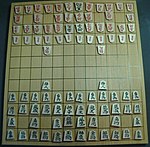|
EuroShogi
EuroShogi is a shogi variant invented by Vladimír Pribylinec starting in 2000.[1] The game developed from an early version of chess variant Echos in 1977, leading to Cubic Chess, then later to Cubic Shogi, and finally to EuroShogi. Instead of the classic figures, 18 black and 18 white cubes are used, which are on two opposing sides without symbols. The other two cubes on the opposite sides have one white and one black symbol. The other opposing sides are the same symbols of the opposite color - their promotion is indicated by a circle around symbol. Symbol on top of its mobility. The pieces are placed on the board so that they are oriented towards players without any symbolic surfaces. Plays on a board with 8x8 fields of the same color. A major tenet of EuroShogi is simplification without radical changes, while maintaining good gameplay. The variant Heian shogi with playing board 8×8 or 9×8 is the only shogi variant somewhat similar to EuroShogi; other variants are larger or smaller, have new units, or lack drops. Game rulesOn the board the furthest three ranks from each player is their promotion zone. The starting setup is as shown. Pieces capture the same as they move. Composition of pieces per player: 1 king, 1 tower, 2 bishops, 2 generals, 2 knights, 8 pawns. MovementKingThe king steps one square in any direction, orthogonal or diagonal. The king does not promote. RookThe rook moves any number of unoccupied squares along any of the four orthogonal directions. Promoted rook is marked by the circle it moves as king too. BishopThe bishop moves any number of unoccupied squares along any of the four diagonal directions. Promoted bishop is marked by the circle, it moves as king too. GeneralThe general steps one square in one of the four orthogonal directions, or one square diagonally forward. (Six possibilities.) The general does not promote. KnightThe knight jumps at an angle intermediate to orthogonal and diagonal, equivalent to: one square frontal forward, then one square diagonally forward, in a single move. The knight leaps over any intervening men. The EuroShogi knight has an additional extension: it can also move one square horizontally to the side. Promoted knight is marked by the circle, it moves as general.
PawnThe pawn steps one square forward. Promoted pawn is marked by the circle, it moves as general. Starting positionWhite: KD1 GC1 GE1 RG2 Bb2 BF1 NB1 NG1, pawns in the whole 3rd row PromotionA player's promotion zone consists of the three farthest ranks. If a player's man crosses into its promotion zone, the player immediately promotes the man at the end of the turn. The king and general cannot promote. A pawn and the knight, after entering into the promotion zone instantly obtain a general movement by rotating its cube. After being dropped from the stack into the promotion zone they do not get promoted instantly, but they can be promoted when they move. A rook becomes a promoted rook, the bishop becomes a promoted bishop. A rook and a bishop dropped from the reservoir into the promotion zone are not promoted instantly, but they can be when they move (out of, or wholly within the zone). DropsEach player owns a stack for staging captured men, which are always stored not to promote. This is achieved by rotating a cube: captured unit changes a colour and loses a promotion. A player whose turn it is to move may either move a man on the chessboard, or drop any man from his stack on any vacant square, but a pawn may not be dropped on a file already containing a pawn of the same color. or on the last rank (there it can not move). Check and checkmateCheck, checkmate, and draws follow the same conditions as in classical chess. However, it is not permitted to give perpetual check in EuroShogi.
See alsoReferences
Bibliography
External links
|
||||||||||||||||||||||||||||||||||||||||||||||||||||||||||||||||||||||||||
Portal di Ensiklopedia Dunia

